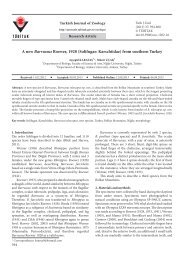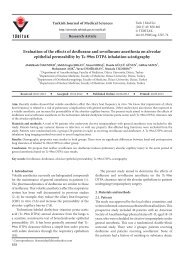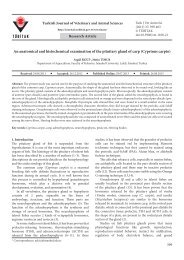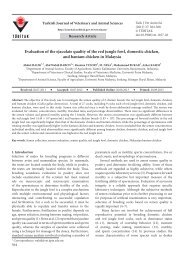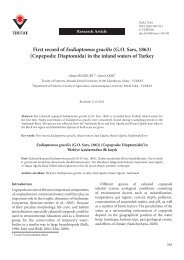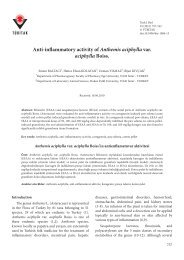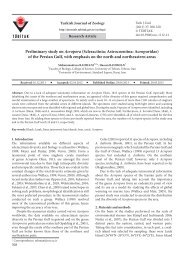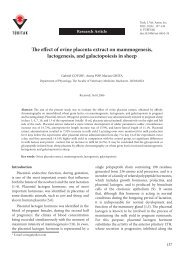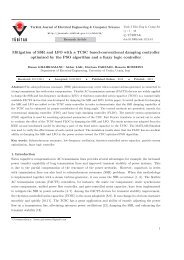Synthesis and optical characterization of Zn1?xMgxS:Eu nanoparticles
Synthesis and optical characterization of Zn1?xMgxS:Eu nanoparticles
Synthesis and optical characterization of Zn1?xMgxS:Eu nanoparticles
You also want an ePaper? Increase the reach of your titles
YUMPU automatically turns print PDFs into web optimized ePapers that Google loves.
Turkish Journal <strong>of</strong> Physics<br />
http://journals.tubitak.gov.tr/physics/<br />
Research Article<br />
Turk J Phys<br />
() : 1 – 7<br />
c⃝ T ÜB˙ ITAK<br />
doi:10.3906/fiz-1208-6<br />
<strong>Synthesis</strong> <strong>and</strong> <strong>optical</strong> <strong>characterization</strong> <strong>of</strong> <strong>Zn1</strong>−xMg xS :<strong>Eu</strong> <strong>nanoparticles</strong><br />
Alex<strong>and</strong>er Nwabueze AMAH, ∗ Audu ONOJAH, Richard AKPAGHER<br />
Department <strong>of</strong> Physics, University <strong>of</strong> Agriculture, Makurdi, Nigeria<br />
Received: 13.08.2012 • Accepted: 18.12.2012 • Published Online: ..2013 • Printed: ..2013<br />
Abstract: <strong>Zn1</strong>−xMg x S : <strong>Eu</strong> 3+ <strong>nanoparticles</strong> were synthesized by a facile co-precipitation technique with varying<br />
magnesium concentrations (0 ≤ x ≤ 0.20). X-ray diffraction results showed a mixture <strong>of</strong> cubic <strong>and</strong> hexagonal structures.<br />
There was an observed peak shift towards higher angles, decrease in peak intensities, disappearance <strong>of</strong> other peaks, <strong>and</strong><br />
increase in diffraction peak broadening as Mg concentration increased. The estimated average particle sizes ranged from<br />
2.0 nm to 8.79 nm. Scanning electron microscopy results showed smooth <strong>and</strong> uniform surface morphology. Energy<br />
dispersive X-ray studies indicated that the samples contained mainly Zn, S, <strong>and</strong> <strong>Eu</strong> because <strong>of</strong> the low detection limit<br />
for Mg. UV-Vis absorption spectrophotometer results showed a blue shift in energy due to quantum confinement as Mg<br />
concentration increased.<br />
Key words: <strong>Zn1</strong>−xMg xS :<strong>Eu</strong> 3+ <strong>nanoparticles</strong>, quantum confinement, hexagonal structure, particle size<br />
1. Introduction<br />
Semiconductor nanostructured materials in recent times have attracted much research interest due to their<br />
remarkable size, shape, surface dependency, <strong>and</strong> <strong>optical</strong>, physical, <strong>and</strong> chemical properties. These unique<br />
properties exhibited by semiconductor nanocrystallites as compared to the bulk phase [1] originate from their<br />
large surface-to-volume ratio <strong>and</strong> quantum confinement effect [2].<br />
An important subset <strong>of</strong> these semiconductor nanocrystals are those doped with a small percentage <strong>of</strong><br />
dopant to alter their electronic, magnetic, <strong>and</strong> <strong>optical</strong> properties for various desired applications [3]. The<br />
impurity incorporated transfers the dominant recombination route from the surface state to the impurity state,<br />
which improved radiative efficiency <strong>and</strong> induced emission significantly [4]. The impurity also increases the<br />
lattice constant <strong>of</strong> the host, thus weakening the crystal field <strong>and</strong> the variation <strong>of</strong> phonon coupling caused by<br />
the doping ion that results in emission at short wavelengths [5].<br />
One important II-VI semiconductor crystal host for doping active ions is ZnMgS. ZnMgS has attracted<br />
much attention because <strong>of</strong> its direct wide b<strong>and</strong> gap energy (3.67 eV) at room temperature, which could<br />
be controlled by changing synthesis conditions in order to achieve a desired ultraviolet (UV) <strong>and</strong> visible<br />
spectra range [6]. The crystalline properties <strong>of</strong> ZnMgS alloy generally may display 3 different structures,<br />
the zinc blend (cubic β -ZnS), wurtzite (hexagonal α-ZnS), <strong>and</strong> rock salt (γ -MgS) [7]. This alloy has large<br />
excitonic emission energy, which makes it a strong c<strong>and</strong>idate for applications in UV detection, plasma display,<br />
electroluminescent phosphor display, light-emitting diodes, solar cells, laser diode, cladding layers [8], <strong>and</strong><br />
fabrication <strong>of</strong> optoelectronic devices in the whole visible range because the b<strong>and</strong> gap can be controlled as a<br />
function <strong>of</strong> Mg concentration, <strong>of</strong>fering a tuning <strong>of</strong> <strong>optical</strong> properties [9].<br />
∗ Correspondence: odunzalex@yahoo.com<br />
1
AMAH et al./Turk J Phys<br />
Rare earth elements are excellent c<strong>and</strong>idates for luminescence centers <strong>of</strong> doped nanostructures due to<br />
their <strong>optical</strong> advantages such as sharp fluorescence emission, large stoke shift, no photo-bleaching, <strong>and</strong> long<br />
luminescent time [10,11]. The emission <strong>of</strong> <strong>Eu</strong> 3+ ions varies from blue to red depending on the host lattice due<br />
to crystal field effects [10].<br />
method.<br />
In this paper, <strong>Zn1</strong>−xMg xS <strong>nanoparticles</strong> are doped with <strong>Eu</strong> 3+ using a facile co-precipitated chemical<br />
2. Experimental procedures<br />
2.1. Materials<br />
The study used zinc sulfate heptahydrate (ZnSO4·7H2O , Kermer Company), magnesium sulfate (MgSO 4·7H2O ,<br />
Sigma Chemical Company), sodium sulfide (Na2S · xH2O , BDH Chemical Company), europium(III) chloride<br />
(Sigma Chemical Company), <strong>and</strong> ethanol (C2H2O , Sigma-Aldrich), <strong>and</strong> deionized water was used as a solvent.<br />
All the reagents were <strong>of</strong> analytical purity <strong>and</strong> were used without further purification.<br />
2.2. Preparation <strong>of</strong> <strong>Zn1</strong>−xMg xS : <strong>Eu</strong> 3+ <strong>nanoparticles</strong><br />
In a typical procedure, 0.1 M ZnSO4·7H2O was mixed with an x-molar concentration <strong>of</strong> MgSO 4·7H2O , where<br />
x = 0.00, 0.05, 0.10, 0.15, <strong>and</strong> 0.20, respectively, <strong>and</strong> a fixed concentration <strong>of</strong> 5 mol% <strong>Eu</strong>Cl3 · 6H2O under<br />
vigorous stirring to obtain a clear solution. The mixture was then refluxed at 90 ◦ C for 1 h <strong>and</strong> the heat<br />
was turned <strong>of</strong>f to allow the solution to cool at room temperature. Next, 0.35 M NaS2 : 2H2O solution was<br />
introduced into the above mixture dropwise under continuous stirring. The white precipitate obtained was<br />
separated from the solution by centrifugation at 3500 rpm. The precipitate was washed 3 times with deionized<br />
water <strong>and</strong> then 3 times with ethanol to remove dissolved impurities. The precipitate was dried in an oven at<br />
80 ◦ C for 24 h. Finally, the obtained white solid was crushed into fine powder.<br />
2.3. Characterization<br />
X-ray diffraction (XRD) patterns <strong>of</strong> the samples were obtained using CuKα (λ = 1.5406 AA) radiation (Radicon<br />
MD-10) with a diffraction angle between 13 ◦ <strong>and</strong> 75 ◦ . Scanning electron microscopy (SEM) studies were<br />
performed using a Carl-Zeiss MA-10 model. UV-Vis absorption spectra were recorded on a Helios AOEL-PD-<br />
303 UV spectrophotometer.<br />
3. Results <strong>and</strong> discussion<br />
3.1. XRD analysis<br />
Figures 1 shows the XRD pattern for <strong>Zn1</strong>−xMg xS :<strong>Eu</strong> 3+ powder at various Mg concentrations <strong>of</strong> x = 0.00,<br />
0.05, 0.10, 0.15, <strong>and</strong> 0.20. The ZnS : <strong>Eu</strong> at a 0.00 Mg concentration shows the hexagonal structure <strong>of</strong> zinc<br />
sulfide with high intensities. The resolved diffraction peaks are (100), (111), (101), (200), (103), (201), <strong>and</strong><br />
(202) reflections <strong>of</strong> mixed cubic <strong>and</strong> hexagonal structures <strong>of</strong> ZnS <strong>and</strong> ZnMgS, respectively (JCPDS No. 891397<br />
<strong>and</strong> 05-0566). The intensity <strong>of</strong> the XRD peaks decreases as Mg composition increases.<br />
This agrees with earlier observations [12]. At the higher concentration <strong>of</strong> x = 0.20, the peak corresponding<br />
to the (111) reflection is essentially broadened. This broadening <strong>of</strong> the peak could arise due to microstraining<br />
<strong>of</strong> the crystal structure as the Mg 2+ ions substitute the Zn 2+ ion in the lattice.<br />
2
AMAH et al./Turk J Phys<br />
The average crystallite sizes were calculated using the Debye–Scherrer formula [5].<br />
D = 0.9λ<br />
β cos θ<br />
Here, λ is the wavelength, D is the average diameter <strong>of</strong> the crystal, θ is the Bragg angle, <strong>and</strong> β is the full width<br />
at half maximum. The crystallite sizes estimated from the major peaks center at 2θ ranges from 2.00 nm to<br />
8.79 nm.<br />
3.2. Scanning electron microscopy (SEM) analysis<br />
The morphology <strong>of</strong> the synthesized <strong>Zn1</strong>−xMg xS :<strong>Eu</strong> 3+ is shown in Figures 2a–2e for<br />
x = 0.00, 0.05, 0.10, 0.15, <strong>and</strong> 0.20, respectively. The surfaces <strong>of</strong> the samples show microstructure<br />
homogeneity. The particles are nearly spherical in nature, showing agglomeration <strong>of</strong> the particles. The elemental<br />
composition studied using energy dispersive X-ray (EDX) (shown in Figure 3 <strong>and</strong> the Table for x = 0.00, 0.05,<br />
0.10, 0.15, <strong>and</strong> 0.20) confirms pure ZnMg : <strong>Eu</strong> with Zn, S, <strong>and</strong> <strong>Eu</strong> being well resolved in the spectrum. Mg<br />
could not be detected by EDX.<br />
Intensity<br />
a.u<br />
100<br />
111<br />
101<br />
200<br />
103<br />
202<br />
15202530354045505560657075<br />
2θ°<br />
X=0.20<br />
X=0.15<br />
X=0.10<br />
X=0.05<br />
X=0.00<br />
Figure 1. The x-ray powder diffraction pattern <strong>of</strong> <strong>Zn1</strong>−xMg xS :<strong>Eu</strong> 3+ <strong>nanoparticles</strong> (0 ≤ x ≤ 0.20).<br />
(1)<br />
3
AMAH et al./Turk J Phys<br />
Figure 2. SEM micrographs <strong>of</strong> <strong>Eu</strong> 3+ doped <strong>Zn1</strong>−xMg x S : (a) x = 0.0, (b) x = 0.05, (c) x = 0.10, (d) x = 0.15, <strong>and</strong><br />
(e) x = 0.20.<br />
3.3. UV-Vis absorption spectroscopy<br />
The <strong>optical</strong> spectra for as-synthesized <strong>Zn1</strong>−xMg xS :<strong>Eu</strong> 3+ <strong>nanoparticles</strong> are shown in Figure 4a. The <strong>optical</strong><br />
absorption spectra have absorption b<strong>and</strong> edges located around 330 nm, 320 nm, 310 nm, 300 nm, <strong>and</strong> 290 nm<br />
for Mg concentrations <strong>of</strong> x = 0.00, 0.05, 0.10, 0.15, <strong>and</strong> 0.20, respectively. The respective energy b<strong>and</strong> gap<br />
associated with these b<strong>and</strong> edge absorptions was determined from Tauc’s relation [13].<br />
4
AMAH et al./Turk J Phys<br />
Table. EDX results <strong>of</strong> elemental composition by weights (in grams).<br />
Element Weight % Atomic %<br />
CK 46.92 66.65<br />
OK 22.71 24.22<br />
AlK 0.53 0.34<br />
SK 6.57 3.50<br />
CuK 0.47 0.13<br />
ZnK 17.49 4.57<br />
<strong>Eu</strong>L 5.30 0.60<br />
Total 100<br />
(a) MgZnS:<strong>Eu</strong>1 for x = 0.00<br />
Element Weight % Atomic %<br />
CK 62.98 77.50<br />
OK 19.30 17.83<br />
AlK 0.81 0.44<br />
SK 3.15 1.45<br />
CuK 0.25 0.06<br />
ZnK 10.94 2.47<br />
<strong>Eu</strong>L 2.57 0.25<br />
Total 100<br />
(c) MgZnS:<strong>Eu</strong>3 for x = 0.10<br />
Element Weight % Atomic %<br />
CK 61.35 76.68<br />
OK 19.54 18.33<br />
AlK 0.65 0.36<br />
SK 3.76 1.76<br />
ZnK 10.82 2.48<br />
<strong>Eu</strong>L 3.88 0.38<br />
Total 100<br />
(e) MgZnS:<strong>Eu</strong>5 for x = 0.20<br />
α =<br />
(hυ − Eg) m<br />
hυ<br />
Element Weight % Atomic %<br />
CK 60.29 75.70<br />
OK 19.75 18.65<br />
AlK 1.19 0.67<br />
SK 3.74 1.76<br />
ZnK 13.03 3.01<br />
<strong>Eu</strong>L 2.10 0.21<br />
Total 100<br />
(b) MgZnS:<strong>Eu</strong>2 for x = 0.05<br />
Element Weight % Atomic %<br />
CK 56.06 73.88<br />
OK 18.74 18.54<br />
AlK 2.26 1.33<br />
SK 4.96 2.45<br />
ZnK 14.01 3.39<br />
<strong>Eu</strong>L 3.96 0.41<br />
Total 100<br />
(d) MgZnS:<strong>Eu</strong>4 for x =0.15<br />
Here, α is the absorption coefficient, h is Planck’s constant, υ is the frequency, m = 1<br />
2<br />
m = 2 for indirect b<strong>and</strong> gap, <strong>and</strong> m = 3<br />
2<br />
(2)<br />
for direct b<strong>and</strong> gap,<br />
for direct forbidden transitions. The value <strong>of</strong> the <strong>optical</strong> b<strong>and</strong> gap<br />
was obtained by extrapolating the straight line portion <strong>of</strong> (αhυ) 2 vs. the hυ graph to (αhυ) 2 = 0 in Figure<br />
4b. The b<strong>and</strong> gaps obtained are 3.92 eV, 3.95 eV, 3.97 eV, 4.00 eV, <strong>and</strong> 3.92 eV for Mg concentrations <strong>of</strong> x =<br />
0.00, 0.05, 0.10, 0.15, <strong>and</strong> 0.20, respectively. The obtained b<strong>and</strong> gaps are blue-shifted to higher energy relative<br />
to the bulk b<strong>and</strong> gap energy <strong>of</strong> 3.67 eV for ZnS. The blue shift could be caused by the quantum confinement<br />
effect.<br />
5
6<br />
ZnMgS:<strong>Eu</strong>1 (x = 0.0)<br />
ZnMgS:<strong>Eu</strong>5 (x = 0.20)<br />
AMAH et al./Turk J Phys<br />
ZnMgS:<strong>Eu</strong>3 (x = 0.10)<br />
Figure 3. EDX results for <strong>Eu</strong> 3+ doped <strong>Zn1</strong>−xMg xS for 0 ≤ x ≤ 0.20.<br />
ZnMgS:<strong>Eu</strong>2(x = 0.05)<br />
ZnMgS:<strong>Eu</strong>4 (x = 0.15)
Absorbance, a.u.<br />
4<br />
3.5<br />
3<br />
2.5<br />
2<br />
1.5<br />
1<br />
0.5<br />
Mg: x = 0<br />
Mg: x = 0.05<br />
Mg: x = 0.10<br />
Mg: x = 0.15<br />
Mg: x = 0.20<br />
0<br />
200 300 400<br />
Wavelength, nm<br />
500 600<br />
AMAH et al./Turk J Phys<br />
(αhν) 2 (eV/m 2 )<br />
2000<br />
1800<br />
1600<br />
1400<br />
1200<br />
1000<br />
800<br />
600<br />
400<br />
200<br />
Mg: x = 0<br />
Mg: x = 0.05<br />
Mg: x = 0.10<br />
Mg: x = 0.15<br />
Mg: x = 0.20<br />
0 2 2.5 3 3.5 4 4.5 5 5.5<br />
Wavelength, nm<br />
Figure 4. a) UV-Vis absorption spectra <strong>of</strong> prepared <strong>Zn1</strong>−xMg xS :<strong>Eu</strong> 3+ <strong>nanoparticles</strong>; b) The b<strong>and</strong> edges <strong>of</strong><br />
<strong>Zn1</strong>−xMg xS :<strong>Eu</strong> 3+ <strong>nanoparticles</strong> at x = 0.00, 0.05, 0.10, 0.15, <strong>and</strong> 0.20.<br />
4. Conclusion<br />
ZnMgS : <strong>Eu</strong> <strong>nanoparticles</strong> have been synthesized using a precipitation method. This is evident from EDX<br />
analysis. The energy b<strong>and</strong> gap <strong>of</strong> the synthesized <strong>nanoparticles</strong> shows a blue shift due to quantum confinement<br />
effects. The XRD analysis showed a mixed structure <strong>of</strong> cubic <strong>and</strong> hexagonal ZnS structure. All the diffraction<br />
peaks showed considerable decrease in their intensities with increasing Mg concentration.<br />
References<br />
[1] G. Murugadoss, B. Rajamannan <strong>and</strong> V. Raimasamy, J. Nanomater. Bios., 5, (2010), 339.<br />
[2] C. Corrado, Y. Jiang, F. Oba, M. Kozina, F. Bridges <strong>and</strong> J. Z. Zhang, J. Phys. Chem., 113, (2008), 3830.<br />
[3] G. H. Li, F. H. Su, B. S. Ma, K. Ding, S. J. Xu <strong>and</strong> N. Chen, Phys. Stat. Sol., 241, (2004), 3248.<br />
[4] H. Ch<strong>and</strong>er, Future Luminescent Materials (Luminescent Materials <strong>and</strong> Devices Group, Electronic Materials Division,<br />
New Delhi, India. 2006) p. 11.<br />
[5] J. Zhang, F. Su, W. Chen, R. Sammynaiken, S. L. Westcott, D. E. McCready, G. Li<strong>and</strong> <strong>and</strong> A. G. Joly, J. Nanosci.<br />
Nanotechnol., 5, (2005), 1465.<br />
[6] E. Omurzak, W. Shimokawa, K. Taniguchi, L. Chen, M. Okamoto, H. Iwasaki, M. Yamasaki, Y. Kawamura, S.<br />
Sulaimankulova <strong>and</strong> T. Mashimo, Jpn. J. Appl. Phys., 50, (2011), 1.<br />
[7] T. Tawara, I. Suemune <strong>and</strong> S. Tanaka, J. Cryst. Growth, 2141215, (2000), 1019.<br />
[8] L. W. Lu, I. K. Sou <strong>and</strong> W. K. Ge, J. Cryst. Growth, 225, (2004), 28.<br />
[9] M. Sohe, M. Munoz <strong>and</strong> M. C. Tamargo, App. Phys. Lett., 85, (2004), 2794.<br />
[10] V. Singh, J. Zhu, M. K. Bhide <strong>and</strong> V. Natarijan, Optical Material, 30, (2007), 446.<br />
[11] Y. Du, Y. Zhang, L. Sun <strong>and</strong> C. Yan, J. Phys. Chem., 112, (2008), 12234.<br />
[12] M. K. Jayaraj, A. Antony <strong>and</strong> P. Denesshan, Thin Films, 389, (2001), 284.<br />
[13] A. Slav, Dig. J. Nanomater. Bios., 6, (2011), 915.<br />
7



